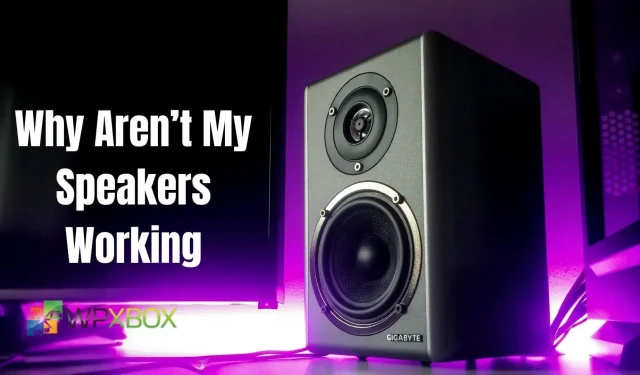On a Windows PC, the sound issue is not new. In most cases, the problem does not occur due to a hardware failure. But misconfigured connections, sound drivers, and other software are to blame. So, if you are wondering why my speakers are not working on Windows 11/10, this post will help you find the answer and solutions to fix the problem.
Why don’t speakers sometimes work?
There are various reasons why speakers may sometimes not work on your computer. Here are some of the main reasons:
- You have configured the audio output settings incorrectly.
- Your speakers are not properly connected to your computer or have stopped working.
- Incorrect output device selected.
- Some required audio services may be disabled.
- Your audio device driver may be outdated, incompatible with your speaker, or corrupted.
Fixed: Why my speakers don’t work on Windows PC
Sound problems are common on Windows computers. But fixing them is not complete. You can use the following methods:
- Check if the audio source is muted
- Check your cables, plugs, connectors, volume, speaker and headphone connections
- Check battery status and Bluetooth connection
- Check speaker output
- Run the Sound Troubleshooter
- Disable sound enhancements
- Driver updates (automatic, manual and third-party)
- Restart audio services
1. Check if the audio source is muted.
First, make sure your speaker is not muted. Most speakers come with a volume control. If it’s set to a low volume or disabled, you won’t hear anything.
2. Check cables, plugs, connectors, volume, speaker and headphone connections.
You should also check if your speakers are properly connected to your computer. Make sure you have plugged the aux cable into the correct port and your speaker is on and working properly.
Also, check all connections between your computer and the speaker and make sure they are all good.
In addition, also check if your speakers are working. To do this, you can try connecting the speakers to another device.
3. Check battery status and Bluetooth connection
Do you use Bluetooth speakers? If yes, make sure your Bluetooth speakers have enough battery. You can also try charging your speakers for about 30 minutes before playing sound on your computer.
Also, make sure you have connected your computer to a Bluetooth speaker. Or you can re-pair both devices. To do this, follow these steps:
- Go to Settings > Bluetooth & Devices > Devices.
- Click on the three dots icon next to the speakers and select “Remove Device”.
- After that, click “Add Device”and follow the on-screen instructions to add Bluetooth speakers.
- Finally, try playing a sound and see if you hear any output.
4. Check speaker output
Make sure you have selected the correct speaker output. If you have selected a different audio output than the one you are using, you will not hear anything. To test speaker output, follow these steps:
- Go to Settings > System > Sound.
- Click “Choose where to play audio”and make sure you have selected the correct speakers.
- If you see too many audio output devices, click on each one and then click “Don’t allow me to disable this device from playing audio.”
5. Run the Sound Troubleshooter
The next thing you can do is run the audio troubleshooter. The audio troubleshooter can help you fix the problem or find the clue behind the problem. To run the troubleshooter, follow these steps:
- Go to Settings > System > Troubleshoot.
- Click “Other troubleshooter”.
- Click the “Run”button next to “Play Audio”.
- Then let Windows run the troubleshooter and fix the problem. Or see if it prompts you for further searching.
6. Turn off sound enhancements.
You can also try disabling audio enhancements. Sound enhancement helps to improve the overall sound quality. But it can also lead to various audio issues.
Therefore, if you have it enabled, you can disable it by doing the following:
- Go to Settings > System > Sound.
- Click “Choose where to play sound.”
- Then click on your speakers.
- Scroll down and turn off Sound enhancement.
7. Restart Audio Services
Restarting your audio services can also help you resolve audio issues on your computer. To do this, you need to follow these steps:
- Go to windows search, type services and run it.
- Now locate the following services: Windows Audio, Windows Audio Endpoint Builder, and Remote Procedure Call (RPC).
- Then right-click on each service and select Restart.
8. Update drivers (automatic, manual and third party)
Finally, speakers not working in Windows could be related to the driver. So, update your audio drivers to see if that fixes the issue. There are three ways to update the audio driver:
Windows Update:
Because Windows now ships driver updates along with Windows Update itself. You need to update Windows to get the latest updates for your drivers.
- Go to Settings > Windows Update > Advanced options.
- Then click “Optional Updates”to open all driver-related updates.
- If any update is available, install it and check if it fixes the sound issue.
Manually:
If you are a laptop or pre-built PC user, you should go to your laptop manufacturer’s website and look for audio drivers using your laptop’s model number. You can go to Google and search for keywords like Dell driver downloads.
Alternatively, if you’re a custom build PC user, you’ll need to find out what kind of motherboard you have. Depending on your motherboard model, you will need to download a sound driver and install it on your computer.
To find out your motherboard model, follow these steps:
- Press Windows + X.
- Go to Windows Terminal.
- Run the command to find out your motherboard model:
плинтус wmic получить продукт, производитель
Third person:
If you don’t want to manually look for drivers, you can use third party software that will do the job for you. You can try this best third party driver update software for Windows. What this software does is that it scans your computer and offers driver updates. In addition, it allows you to download the driver using the software and install it on your computer.
Conclusion
That’s it for your question about why speakers don’t work properly in Windows 11/10. You can get rid of most sound problems by updating your audio driver. In any case, now it’s your turn to test these methods. If you get stuck on anything, please leave a comment below.
How to reset sound drivers in Windows?
You can fix most sound problems in Windows by resetting your sound driver. To do this, go to Settings > System > Sound. Then scroll down and tap Volume Mixer, then scroll down and tap the Reset button next to Reset sound devices and volume for all apps to recommended settings.
Does Windows use Realtek?
Yes, Windows PC uses Realtek. However, not all Realtek audio drivers will work with your PC. Instead, download audio drivers based on your device’s model number.


